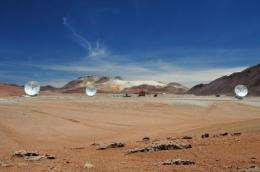Closing the loop for ALMA

On 20 November 2009 the third antenna for the ALMA observatory was successfully installed at the Array Operations Site, the observatory's "high site" on the Chajnantor plateau, at an altitude of 5000 metres in the Chilean Andes. Later, after a series of technical tests, astronomers and engineers observed the first signals from an astronomical source making use of all three 12-metre diameter antennas linked together, and are now working around the clock to establish the stability and readiness of the system.
"The first signal using just two ALMA antennas, observed in October, can be compared to a baby's first babblings," says Leonardo Testi, the European Project Scientist for ALMA at ESO. "Observing with a third antenna represents the moment when the baby says its very first, meaningful word — not yet a full sentence, but overwhelmingly exciting! The linking of three antennas is indeed the first actual step towards our goal of achieving precise and sharp images at submillimetre wavelengths."
The successful linking of the antenna trio was a key test of the full electronic and software system now being installed at ALMA, and its success anticipates the future capabilities of the observatory. When complete, ALMA will have at least 66 high-tech antennas operating together as an "interferometer", working as a single, huge telescope probing the sky in the millimetre and submillimetre wavelengths of light. The combination of the signals received at the individual antennas is crucial to achieve images of astronomical sources of unprecedented quality at its designed observing wavelengths.
The three-antenna linkup is a critical step towards the observatory's operations as an interferometer. Although the first, successful measurements employing just two antennas were obtained at the ALMA high site from October 2009 (see ESO Announcement) and demonstrated the excellent performance of the instruments, the addition of the third antenna is a leap of vital importance into the future of the observatory. This major milestone for the project is known as "phase closure" and provides an important independent check on the quality of the interferometry.
"The use of a network of three (or more) antennas in an interferometer dramatically enhances its performance over a simple pair of antennas," explains Wolfgang Wild, the European ALMA Project Manager. "This gives astronomers control over possible features which degrade the quality of the image, arising due to the instrument or to atmospheric turbulence. By comparing the signals received simultaneously by the three individual antennas, these unwanted effects can be cancelled out — this is completely impossible using only two antennas."
To achieve this crucial goal, astronomers observed the light coming from a distant extragalactic source, the quasar QSO B1921-293, well known to astronomers for its bright emission at very long wavelengths, including the millimetre/submillimetre range probed by ALMA. The stability of the signal measured from this object shows that the antennas are working impressively well.
Several additional antennas will be installed on the Chajnantor plateau over the next year and beyond, allowing astronomers to start producing early scientific results with the ALMA system around 2011. After this, the interferometer will steadily grow to reach its full scientific potential, with at least 66 antennas.
ALMA, an international astronomy facility, is a partnership of Europe, North America and East Asia in cooperation with the Republic of Chile.
The Atacama Large Millimeter/submillimeter Array (ALMA), an international astronomy facility, is a partnership of Europe, North America and East Asia in cooperation with the Republic of Chile. ESO is the European partner in ALMA. ALMA, the largest astronomical project in existence, is a revolutionary telescope, comprising an array of 66 giant 12-metre and 7-metre diameter antennas observing at millimetre and submillimetre wavelengths. ALMA will start scientific observations in 2011.
More information:
More info: ESO ALMA web pages: www.eso.org/alma
More info: ALMA Observatory web pages: www.almaobservatory.org/
Provided by ESO



















